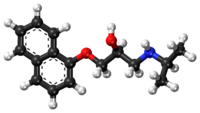
Photo from wikipedia
ETHNOPHARMACOLOGICAL RELEVANCE Hanchuan Zupa Granule (HCZP) is a classic prescription of Uyghur medicine, that is used for cough and abnormal mucinous asthma caused by a cold and "Nai-Zi-Lai". AIM OF… Click to show full abstract
ETHNOPHARMACOLOGICAL RELEVANCE Hanchuan Zupa Granule (HCZP) is a classic prescription of Uyghur medicine, that is used for cough and abnormal mucinous asthma caused by a cold and "Nai-Zi-Lai". AIM OF THE STUDY This study aimed to explore the possible molecular mechanism of HCZP in the treatment of asthma, using a network pharmacology method and in vivo experiments. MATERIALS AND METHODS First, we conducted qualitative analysis of the chemical composition of HCZP as a basis for network pharmacology analysis. Using network pharmacology tools, the possible signaling pathways of HCZP in the treatment of asthma were obtained. An OVA-sensitized asthma model was established, and HCZP was continuously administered for one week. BALF was collected for cell counting, and serum and lung tissues were collected to analyze the expression of IgE, IL-4, IL-5, IL-13 and IFN-γ. Hematoxylin & eosin (H&E) staining was performed to assess the pathological changes in the lung tissues. Related protein expression in the lung tissues was analyzed by Western blotting for molecular mechanism exploration. RESULTS Fifty-six chemical compounds were identified by UPLC Q-TOF MS. According to the network pharmacology results, 18 active compounds were identified among the 56 compounds, and 68 target genes of HCZP in the treatment of asthma were obtained. A total of 19 pathways were responsible for asthma (P < 0.05) according to KEGG pathway analysis. In vivo results showed that OVA sensitivity induced increased respiratory system resistance and inflammatory responses, which included inflammatory cell infiltration and high levels of IgE, IL-4, IL-5 and IL-13 in serum and lung tissues. Furthermore, OVA up-regulated p-PI3K, p-JNK and p-p38 expression in lung tissues. Moreover, HCZP treatment significantly downregulated respiratory system resistance, and the expressions of IL-4, IL-5, IL-13 and IgE, as well as significantly improved inflammatory cell infiltration in lung tissues. Moreover, the protein expression of p-PI3K, p-JNK and p-p38 in lung tissues decreased after HCZP treatment. CONCLUSION HCZP significantly inhibited the OVA-induced inflammatory response via the PI3K-Akt and Fc epsilon RI signaling pathways.
Journal Title: Journal of ethnopharmacology
Year Published: 2021
Link to full text (if available)
Share on Social Media: Sign Up to like & get
recommendations!